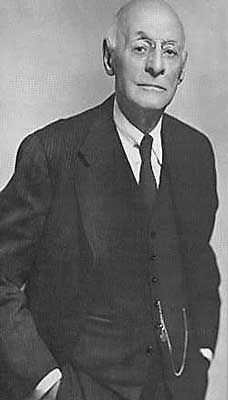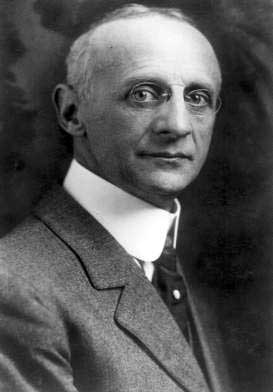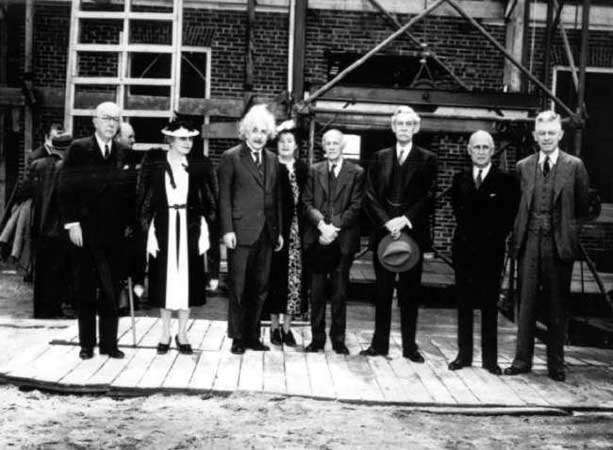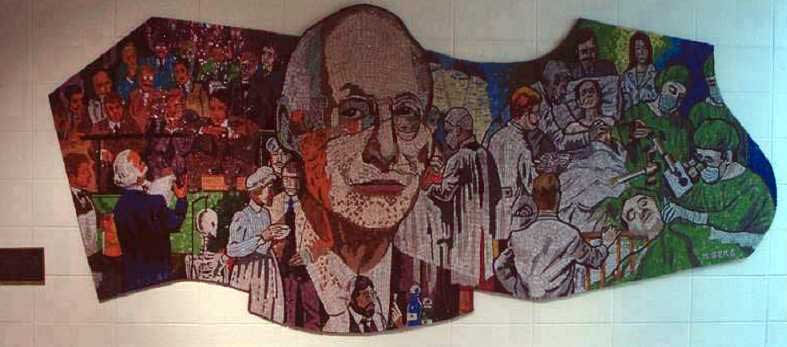M. Saleem Seyal
Louisville, Kentucky, USA

O, Abraham Flexner! . . . We have fought with you on minor points, have alternately admired and disliked you, have applauded you for your wisdom and detested you for opinionatedness. But in just retrospect, layman as you are, we hail you as the father . . . or, better, the uncle of modern medical education in America.
– Dr. Hans Zinsser (1878–1940)1
On the evening of April 23, 1956, a spry and distinguished 89-year-old Abraham Flexner was honored in the Great Ballroom of the Waldorf Astoria in New York City in front of over 300 attendees, including the deans of 57 out of 81 medical schools in the United States. He received the prestigious Frank H. Lahey Memorial Award for “outstanding leadership in medical education,” presented on behalf of three organizations: the American Medical Association (AMA), the Association of American Medical Colleges (AAMC) and the National Fund for Medical Education (NFME). He was hailed as the man who made “the greatest single contribution that [had] ever been made to the advancement of medical education in America.”2 As a non-physician, the gratification Flexner felt at this auspicious gathering must have been immense, even though he had enjoyed the limelight for many decades as an educational reformer, having been catapulted into medical education icon status almost half a century before this tribute. In his acceptance speech, he was modest, humble, and quick to point out that the real credit for improving medical education standards belonged to a few other heroes in medicine and philanthropy, notably Dr. William Welch, Dean of the Johns Hopkins Medical School, Henry S. Pritchett, President of the Carnegie Foundation for the Advancement of Teaching (CFAT), Dr. Arthur D. Bevan, Chairman of the Council on Medical Education (CME) of the AMA, and Frederick T. Gates of the Rockefeller Foundation.2 In his autobiography, he commented, “I was nothing but an industrious and perhaps intelligent thief, all my ideas having been taken from others and I deserving at most the credit of getting them and putting them together.”3 From his impoverished upbringing in Louisville to achieving the pinnacle of power and prestige as an educational reformer and critic, his multifaceted life became the quintessential American success story.

Abraham Flexner was the youngest son of nine children born to Moritz and Esther Flexner, a poor East European Jewish immigrant couple who had settled in Louisville, Kentucky. Flexner’s father was an itinerant peddler who later became a modestly successful hat merchant. At Louisville Male High School, Flexner was a stellar student. He worked at the Louisville Library, where he read books voraciously and listened to the discussions of the city’s elite who used the library as a venue for intellectual discourse. Flexner’s eldest brother, Jacob, ran a successful pharmacy where local physicians gathered for discussion; he eventually earned an MD degree from the University of Louisville and practiced medicine in his hometown. Flexner’s brother Simon became a pharmacist and a self-taught microscopist and pathologist whose opinion was sought by local physicians at Jacob’s pharmacy. Simon earned an MD degree from the University of Louisville and, at the urging of his younger brother, Abraham, went to Johns Hopkins University to become a pathologist under the tutelage of Dr. William Welch. Little did Jacob and Simon know that the medical school that conferred on them their MD degrees was “one of the wretched schools that then flourished throughout the country and especially in Louisville and Chicago.”8 Simon’s career blossomed, and he achieved high academic ranks at Johns Hopkins, later serving as professor of pathology at the University of Pennsylvania. He eventually was appointed the director of the Rockefeller Institute for Medical Research in New York (now Rockefeller University), the first research center in the United States, remaining in that post for over 30 years. Dr. Simon Flexner became quite famous and influential due to his prodigious research activities and administrative skills.
In 1884 at age 17, Abraham Flexner enrolled at Johns Hopkins University in Baltimore with his older brother Jacob’s encouragement and financial support. Abraham would later recall that taking this step “marked the turning point in the history of our family.”3,4 He earned his bachelor’s degree in two years by doubling up on classes. Hopkins’ emphasis on independent study, experimentation, and scientific inquiry, which was reminiscent of the German model of pedagogy, permeated Abraham Flexner’s subsequent work.

After graduation, Abraham Flexner returned home and, at age 19, started teaching at Louisville Male High School. In 1890, at the urging of a local attorney whose son needed preparatory tutoring for college admission, Flexner started his own private school with the enrollment of five students. Mr. Flexner’s School was a unique and highly successful venture with progressive educational ideas which garnered a national reputation. He was proud of the unconventional pedagogic methods of his experimental school where “the school operated without rules, without examinations, without records, and without reports.”5 Mr. Flexner’s school provided Flexner financial security and a tremendous boost as an educational theorist. He married his former pupil, Anne Lazier Crawford, after she graduated from Vassar College and returned to Louisville as a teacher at Mr. Flexner’s School. In September 1904, Flexner informed Anne that he was ready for a change in his career after 19 years of being bound to Louisville like Prometheus: “I want to influence in some measure the life of my time in so far as that can be done through education.”6 To broaden his own educational horizons, he sold his school in 1905 and embarked on the next phase of his life.
Abraham studied at Harvard for one year, receiving his master’s degree in Philosophy. He then sailed to Europe with his wife and infant daughter, Eleanor. After brief stops at Oxford and Cambridge to learn about their educational organizations, he settled for a year at the Berlin University. In 1908 he wrote a scathing critique titled “The American College,” which discussed the deficiencies of American college education. On his return to the United States, undoubtedly on the recommendation of his brother Simon, he was recruited by Henry Pritchett, President of the CFAT, to conduct a survey of medical schools in North America.
The Flexner report, published as “Medical Education in the United States and Canada—Bulletin Number Four,”8 was the result of a blitzkrieg survey of 155 medical schools over 16 months, under the auspices of CFAT and behind-the-scenes collaboration with the AMA. The survey was guided by Flexner’s own personal maxim, ambulando discimus (we learn by going about); he crisscrossed the country via horse, buggy, train, and occasionally Ford Flivver. The groundbreaking Flexner report caused a major stir with its incisive and caustic language describing the sorry state of medical education and was lauded as the epitome of muckraking journalism with its stinging descriptions. It not only pointed out the problems of the extant system of medical education with lax entry criteria, poorly equipped laboratories, profit-motivated teachers, and paucity of university affiliation, it also offered a blueprint to reform the status quo. Reforms had been proposed for several years, but the Flexner report, and the subsequent implementation of the proposed reforms after Flexner joined the Rockefeller Foundation, hastened the demise of the for-profit diploma mills. His proposed plan, when implemented through the philanthropic largesse of the Rockefeller Foundation, brought sweeping changes in medical education and was a catalyst for the standardization of medical education in the United States and abroad.
Flexner was a stupendously persuasive fundraiser, raising a staggering 600 to 700 million dollars for philanthropy from the Rockefellers, Andrew Carnegie, JP Morgan, Payne Whitney, George Eastman, and many others. Many schools, including Johns Hopkins, Washington University, the University of Chicago, Vanderbilt, Yale, Howard, and the University of Rochester received these funds to improve physical facilities and laboratories and to hire full-time faculty. His books about comparative medical education in Europe and his compilation of lectures as a Rhodes Trust lecturer in England, later published as Universities, were highly acclaimed. Flexner conducted surveys of public education in the South, in Maryland and in Gary, Indiana. In 1916, he was instrumental in establishing the Lincoln School at the Teachers College of Columbia University as an experimental school for elementary and secondary curricula. According to historians, this school has had a lasting influence on American education.

In 1933, after he retired from the Rockefeller Foundation, Flexner accepted a bequest of eight million dollars from New Jersey department store magnet Louis Bamberger and his sister Caroline Fuld to establish the Institute for Advanced Study (IAS) in Princeton, New Jersey. The IAS was the result of one man’s vision of founding a higher education edifice in the middle of the Great Depression that was quite dissimilar to the university model; a place where no classes were taught, no degrees were awarded, and there were no financial pressures. The IAS became a fortress of learning, a Platonic refuge for scholars, physicists, mathematicians, and logicians. As founder and director, Flexner was singularly responsible for enticing Albert Einstein to join the IAS. He envisioned this intellectual powerhouse as “a haven where scholars and scientists may regard the world and its phenomena as their laboratory without being carried off in the maelstrom of the immediate.”7 Writing to his friend and fellow Louisville-native Justice Louis Brandeis on March 23, 1932, before embarking on the IAS initiative, Flexner exulted, “In this proposed Institute for Advanced Study I shall smash precedents freely, and nobody will stop me.” The IAS represented the zenith of Flexner’s educational ideals and his “worship of excellence” and would serve as a paradigm to harmonize the humanities and science. Abraham Flexner’s successors remained faithful to his vision in providing an ideal environment for high-level research by a small number of eminent permanent professors and temporary members.10 In this “paradise for scholars” created in the middle of the Great Depression, Flexner was able to link theory (mathematics), application (economics and politics), and heart (humanistic studies).9

Dr. Harold Berg
University of Louisville School of Medicine
Flexner retired in 1939 at the age of 72, but continued writing books, including two autobiographies: I Remember in 19403 and a revised edition, Abraham Flexner: An Autobiography,4 published posthumously in 1960. He died at the age of 93 in 1959 and is buried next to his wife in Cave Hill Cemetery in Louisville. The Chicago Tribune stated, “Abraham Flexner was one of the movers and shakers of his era. The world is a different and better one thanks to his influence,” while The New York Times’ view on his death was, “No other American of his generation had done more for the welfare of his country and for humanity in general.” Thomas Bonner, his definitive biographer, described Flexner very aptly as “an esteemed figure in American life . . . (whose) life had been full of remarkable, even historic achievements . . . He was fundamentally a deeply gifted human being, warm-hearted, decent and dedicated to his causes and extended family.”9 Edward Frohlich wrote about the two brothers, Abraham and Simon Flexner as his initial choices for the two premier leaders in the forefront of American medical leaders of the twentieth century.11
During his life as an educational reformer and critic, Abraham Flexner was feared and revered by the educational hierarchy, medical and non-medical, and his influence endures 100 years after the publication of the Flexner report. His autobiography ends with a quote from Thomas Carlyle, depicting a bookplate with a lighted candle and the words “I burn that I may be of use.”4 Flexner’s candle never flickered and has left a glow that has illuminated American education for over a century.
Notes
- Zinsser, H. As I Remember Him. The Biography of R.S.: Little, Brown and Company, Boston, 1940. P.131
- “Abraham Flexner: A Tribute,” program of The National Fund for Medical Education, 1956, Abraham Flexner Papers (quoted by Bonner, TN, p.351)
- Flexner, A. I Remember. Simon & Schuster, New York, 1940
- Flexner, A. An autobiography—A complete revision, brought up to date, of the author’s I REMEMBER, published in 1940. Introduction by Allan Nevins. Simon and Schuster, New York. 1960. P.292
- Ibid. p.45
- Ibid. p.61
- Ibid. p.236
- Flexner, A. Medical Education in the United States and Canada: A Report to the Carnegie Foundation for the Advancement of Teaching. Bulletin Number Four. 1910.
- Bonner, TN. Iconoclast—Abraham Flexner and a Life in Learning. The Johns Hopkins University Press, Baltimore and London, 2002.
- Batterson, S. Pursuit of Genius—Flexner, Einstein, and the Early Faculty at the Institute for Advanced Study. AK Peters, LTD, Wellesley, Massachusetts, 2006. P.261
- Gunderman, RB, Gascoine, K, Hafferty FW, Kanter, S. A “Paradise for Scholars”: Flexner and the Institute for Advanced study. Academic Medicine. 2010;85:1784-1789
- Frohlich, ED. Leadership in American Medicine as I see It: A Background in the Beginning (Editorial). The Ochsner Journal, 2012.12:302-307
M. SALEEM SEYAL, MD, FACC, FACP, graduated from Nishtar Medical College (University of the Punjab) in Multan, Pakistan in 1974 and completed his residency in Internal Medicine at Louis A Weiss Memorial Hospital in Chicago. He received his training in cardiology at the University of Illinois in Chicago. Dr. Seyal is board-certified in cardiovascular medicine, interventional cardiology, clinical lipidology, and nuclear cardiology. He has been a practicing cardiologist for 30 years. He serves as an associate clinical professor of medicine at the University of Louisville School of Medicine.
Highlighted in Frontispiece Volume 5, Issue 3 – Summer 2013

Leave a Reply